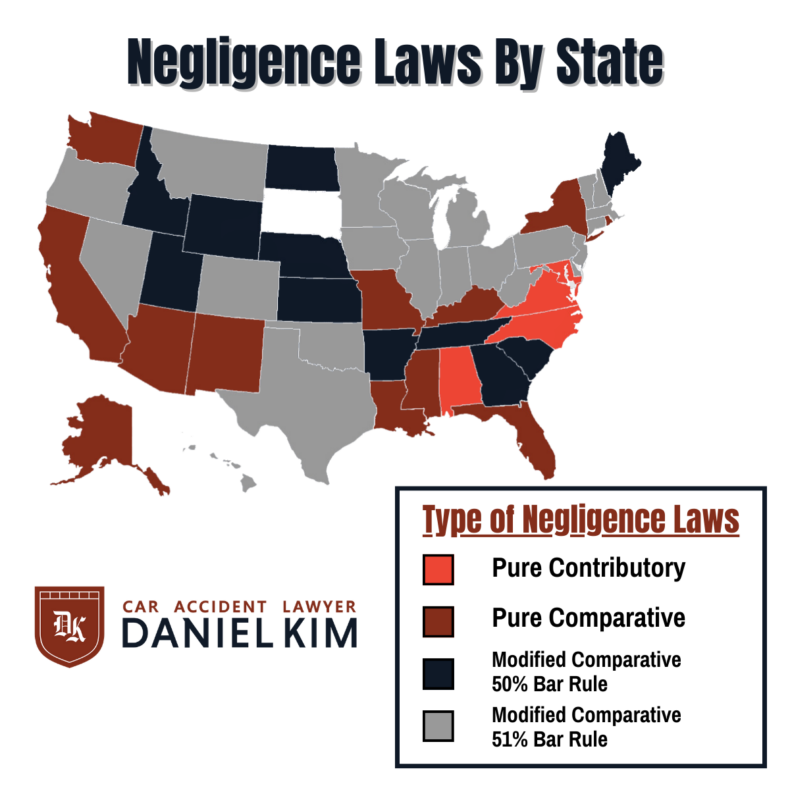What Is Comparative Negligence?
To understand comparative negligence, one must understand what negligence is in the legal sense. Negligence is the failure to take reasonable care, resulting in injury or wrongful death to another person. Simply put, negligence is carelessness. Most car accidents, truck accidents, and motorcycle accidents are caused by negligence and serve as the basis for most personal injury claims in California.
Comparative negligence, also known as comparative fault, is a legal principle used in tort law to determine the how much a plaintiff can recover in a personal injury claim. Essentially, it reduces the amount of damages that a plaintiff can recover in a negligence-based claim, based on their percentage of fault. In other words, if you were partly at fault for the accident that caused your injury, you may not be able to recover the full amount of compensation that you would otherwise be entitled to.
For example, if you were driving 10 miles per hour over the speed limit when another driver ran a red light and hit your car. You suffered $100,000 in damages as a result of the collision. If the judge or jury finds that you were 20% at fault for the accident because of your speeding, and the other driver was 80% at fault for running the red light, your recovery will be reduced by 20%. This means that you will only receive $80,000 in damages from the other driver.
Types of Comparative Negligence
Understanding the three different types of comparative negligence rules is important if you were involved in an auto accident, as it will impact your settlement amount.
Pure Comparative Negligence
California follows pure comparative negligence rule. Under this rule, the plaintiff can recover damages even if they are 99% at fault for the accident. The plaintiff’s recovery is reduced by their percentage of fault. For example, if the plaintiff is 90% at fault and the defendant is 10% at fault, the plaintiff can still recover 10% of their damages. This law attempts to resolve issues of fault when multiple parties are involved, like in a multi-vehicle collision. Currently, there are 13 pure comparative fault states.
Modified Comparative Negligence
Modified comparative negligence states put more restrictions on a plaintiff’s ability to recover damages. Under this rule, the plaintiff can only recover damages if they are less than 50% or 51% at fault for the accident. Like pure comparative negligence, their settlement amount will be reduced according to the percentage of fault. For example, if the plaintiff is 30% at fault and the defendant is 70% at fault, the plaintiff can recover 70% of their damages from the defendant. However, if the plaintiff is 50% or more at fault, they cannot recover anything. More than half of U.S. states follow this rule.
- 50% Rule: The 50% rule allows a plaintiff to recover damages only if he or she is less than 49% at fault or less. If the plaintiff’s negligence is 50% or more, he or she is barred from recovering damages.
- 51% Rule: The 51% rule allows a plaintiff to recover damages only if he or she is not 51% or more at fault. Therefore, both the plaintiff and the defendant can be equally at fault (50/50) and still claim damages for their own injuries.
Contributory Negligence
This is the strictest negligence law. In a contributory negligence state, a plaintiff cannot recover any damages if even the smallest amount of their own negligence contributed to the accident. Even if the plaintiff is only 1% at fault and the defendant is 99% at fault, the plaintiff is unable to recover anything. Only four states and Washington D.C. follow this rule.
Slight vs. Gross Negligence
South Dakota is the only state that recognizes the slight/gross negligence rule, which combines both comparative and contributory negligence laws. This law states that someone may be able to recover damages only if their fault was “slight” and the other party’s fault was “gross” or greater. If this distinction cannot be made, the injured person cannot recover any damages.
What Are the Elements of Proving Negligence?
Personal injury lawsuits are generally based on negligence. To win a negligence case, the plaintiff (the injured person) must prove the following four elements to show that the defendant (the person allegedly at fault) acted in a negligent or reckless way:
- Duty: The defendant owed a legal duty of care to the plaintiff. This means that the defendant had a responsibility to act with reasonable caution. For example, a driver has a duty of care to other drivers and pedestrians on the road.
- Breach: The defendant breached the duty of care by failing to act as a reasonable person would have under the same circumstances. This means that the defendant’s actions fell below the expected standard of care. For example, a driver who runs a red light or texts while driving has breached the duty of care to other drivers.
- Causation: The defendant’s breach of duty was the direct cause of the plaintiff’s injury. The defendant’s negligence caused and predicted the plaintiff’s injury.
- Damages: The plaintiff suffered actual harm or loss as a result of the defendant’s negligence. This means that the plaintiff incurred medical expenses, lost income, or other types of damages from the accident and injuries.
Contact an Orange County Personal Injury Lawyer
If you were injured in a car accident due to someone else’s negligence, it’s important to speak with an experienced personal injury lawyer. Our Orange County personal injury law firm can guide you through California’s pure comparative negligence law and help you recover maximum compensation from the other driver’s insurance company. Contact our law office online or give us a call at (800) 719-9779 to discuss your case.



